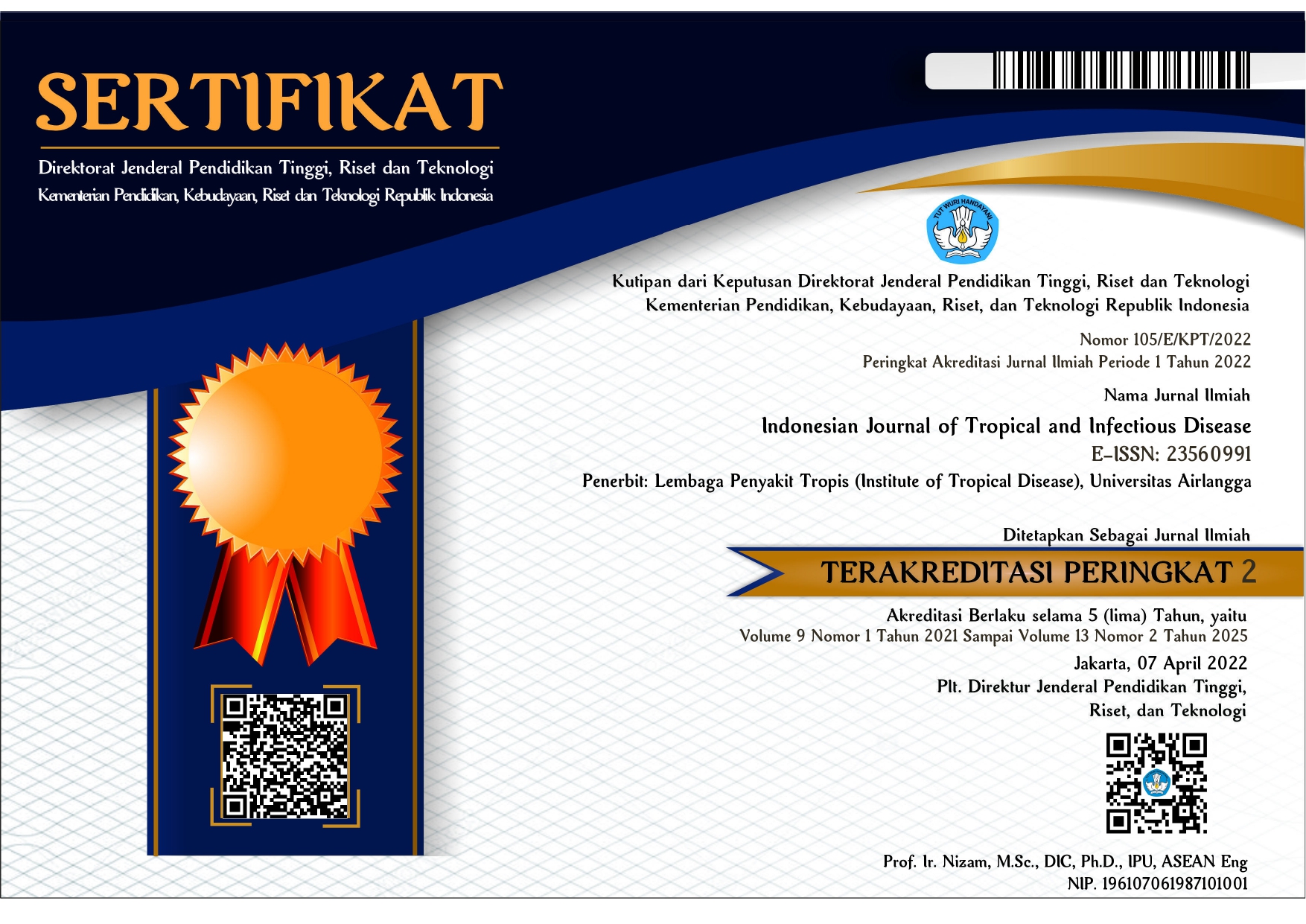The Role of Host Genetics Regulating Proteins in HIV-1 Susceptibility: Epidemiological and Demographic Insights on HIV-1 in Indonesia (2022)
Downloads
Human Immunodeficiency Virus type 1 (HIV-1) remains a global public health concern, marking 52,995 cases in Indonesia alone, dominated with CRF01_AE strain which is classified as an X4 strain or a virus that uses CXCR4 co-receptor. This highlights the urgent needs to develop therapies that utilize CXCR4 inhibitors to modulate HIV-1 infection and replication. The aims of this study were to assess the epidemiological and demographic insights on HIV-1 in Indonesia in 2022, and connecting it to the dominated strain to further assess various host genetics known to promote HIV-1 infection, focusing on the co-receptors CCR5 and CXCR4. A systematic review was conducted, analyzing published studies and the 2022 HIV/AIDS report from the Ministry of Public Health of Indonesia. Additionally, the study evaluated the therapeutic potential of CXCR4 antagonists, including AMD3100, AMD070, BPRCX807, and MCo-CVX-5c, known for their anti-HIV-1 activity. Among the listed antagonists, AMD070 and MCo-CVX⎯5c are advancing among the others, leading to a potential most advanced combination antiretroviral therapy (cART). This research contributed to the development of personalized treatment strategies for HIV-1 by providing insights into the genetic factors influencing co-receptor regulation and HIV-1 susceptibility.
Naranbhai V, Carrington M. Host genetic variation and HIV disease: from mapping to mechanism. Immunogenetics [Internet]. 2017; 69(8):489–98. Available from: https://www.ncbi.nlm.nih.gov/pmc/articles/PMC5537324/
Chen B, S C, RB S, H V, SS S, A G. Molecular mechanism of HIV-1 entry. Trends Microbiol. 2019 Oct; 27(10):878–91.
Lopalco L. Tackling HIV: Genetic vs. immune CCR5 targeting. J AIDS Clin Res. 2014; 5(9).
González‐Arriagada WA, García IE, Martínez-Flores R, Morales-Pison S, Coletta RD. Therapeutic perspectives of HIV-associated chemokine receptor (CCR5 and CXCR4) antagonists in carcinomas. Int J Mol Sci. 2022 Dec 28; 24(1):478–8.
Laporan Tahunan HIV/AIDS Tahun 2022 – Ditjen P2P Kemenkes RI [Internet]. Kemkes.go.id. 2022. Available from: https://p2p.kemkes.go.id/laporan-tahunan-hiv-aids/
Mulyani M, Ulfah RRM, Nurfitria RS. Incidence, prevalence, and pattern of tuberculosis treatment in HIV/AIDS patients in Regional General Hospital of Bandung City. J Community Health. 2019; 5(3).
Khairunisa SQ, Megasari NLA, Ueda S, Budiman W, Kotaki T, Nasronudin, et al. 2018–2019 update on the molecular epidemiology of HIV-1 in Indonesia. AIDS Res Hum Retroviruses. 2020 Nov 1; 36(11):957–63.
Indriati DW, Witaningrum AM, Yunifiar MQ, Khairunisa SQ, Ueda S, Kotaki T, et al. The dominance of CRF01_AE and the emergence of drug resistance mutations among antiretroviral therapy-experienced, HIV-1-infected individuals in Medan, Indonesia. Acta Med Indones. 2020; 52(4).
Khairunisa SQ, Megasari NLA, Ueda S, Kotaki T, Hidayati AN, Nasronudin, et al. Subtype distribution and drug resistance patterns among HIV-1 strains prevalent in Makassar, Indonesia. AIDS Res Hum Retroviruses. 2023; 39(3):124–9.
Selyutina A, Persaud M, Simons LM, Bulnes-Ramos A, Buffone C, Martinez-Lopez A, et al. Cyclophilin A prevents HIV-1 restriction in lymphocytes by blocking human TRIM5α binding to the viral core. Cell Rep [Internet]. 2020 Mar 17 [cited 2023 Dec 13]; 30(11):3766–3777.e6. Available from: https://www.sciencedirect.com/science/article/pii/S2211124720302746
Mamatis JE, Pellizzari-Delano IE, Gallardo-Flores CE, Colpitts CC. Emerging roles of cyclophilin A in regulating viral cloaking. Front Microbiol. 2022 Feb 15; 13.
Kim K, Dauphin A, Komurlu S, McCauley SM, Yurkovetskiy L, Carbone C, et al. Cyclophilin A protects HIV-1 from restriction by human TRIM5α. Nat Microbiol. 2019 Oct 21; 4(12):2044–51.
Chen F, Ke Q, Wei W, Cui L, Wang Y. Apolipoprotein E and viral infection: Risks and mechanisms. Mol Ther Nucleic Acids. 2023 Sep 1; 33:529–42.
Lunardi LW, Bragatte MA de S, Vieira GF. The influence of HLA/HIV genetics on the occurrence of elite controllers and a need for therapeutics geotargeting view. Braz J Infect Dis. 2021 Sep; 101619.
Mohamed H, Gurrola T, Berman R, Collins M, Sariyer IK, Nonnemacher MR, et al. Targeting CCR5 as a component of an HIV-1 therapeutic strategy. Front Immunol [Internet]. 2022 Jan 20; 12:816515. Available from: https://www.ncbi.nlm.nih.gov/pmc/articles/PMC8811197/
Henrich TJ, Hanhauser E, Harrison LJ, Palmer CD, Romero-Tejeda M, Jost S, et al. CCR5-Δ32 heterozygosity, HIV-1 reservoir size, and lymphocyte activation in individuals receiving long-term suppressive antiretroviral therapy. J Infect Dis. 2015 Oct 28; 213(5):766–70.
Latinovic OS, Reitz M, Heredia A. CCR5 inhibitors and HIV-1 infection. J AIDS HIV Treat. 2018 Dec 20; 11(1):1–5.
Vicenzi E, Liò P, Poli G. The puzzling role of CXCR4 in human immunodeficiency virus infection. Theranostics [Internet]. 2013 [cited 2019 Nov 5]; 3(1):18–25. Available from: https://www.ncbi.nlm.nih.gov/pmc/articles/PMC3563077/
Debnath B, Xu S, Grande F, Garofalo A, Neamati N. Small molecule inhibitors of CXCR4. Theranostics. 2013; 3(1):47–75.
Armani-Tourret M, Zhou Z, Gasser R, Staropoli I, Cantaloube-Ferrieu V, Benureau Y, et al. Mechanisms of HIV-1 evasion to the antiviral activity of chemokine CXCL12 indicate potential links with pathogenesis. PLOS Pathog. 2021 Apr 19; 17(4). doi:10.1371/journal.ppat.1009526.
Grande F, Occhiuzzi M, Rizzuti B, Ioele G, De Luca M, Tucci P, et al. CCR5/CXCR4 dual antagonism for the improvement of HIV infection therapy. Molecules. 2019 Feb 2; 24(3):550.
Guo J, Yan Y, Zhang JF, Ji J, Ge Z, Ge R, et al. Co-receptor tropism and genetic characteristics of the V3 regions in variants of antiretroviral-naive HIV-1 infected subjects. Epidemiol Infect. 2019 Jan 1; 147.
Walenkamp AME, Lapa C, Herrmann K, Wester HJ. CXCR4 ligands: The next big hit? J Nucl Med [Internet]. 2017 Sep 1; 58(Suppl 2):77S–82S. Available from: https://jnm.snmjournals.org/content/58/Supplement_2/77S
Wang J, Tannous BA, Poznansky MC, Chen H. CXCR4 antagonist AMD3100 (plerixafor): From an impurity to a therapeutic agent. Pharmacol Res. 2020 Sep; 159:105010.
Huang LSM, Snyder EY, Schooley RT. Strategies and progress in CXCR4-targeted anti-human immunodeficiency virus (HIV) therapeutic development. Clin Infect Dis. 2021 Sep 7; 73(5):919–24.
Zhao R, Liu J, Li Z, Zhang W, Wang F, Zhang B. Recent advances in CXCL12/CXCR4 antagonists and nano-based drug delivery systems for cancer therapy. Pharmaceutics [Internet]. 2022 Jul 25; 14(8):1541. Available from: https://www.ncbi.nlm.nih.gov/pmc/articles/PMC9332179/
Galsky MD, Vogelzang NJ, Conkling P, Raddad E, Polzer J, Roberson S, et al. A phase I trial of LY2510924, a CXCR4 peptide antagonist, in patients with advanced cancer. Clin Cancer Res. 2014 Jun 30; 20(13):3581–8.
Fricker SP. Physiology and pharmacology of plerixafor. Transfus Med Hemother. 2013; 40(4):237–45.
Uchida D, Kuribayashi N, Kinouchi M, Sawatani Y, Shimura M, Mori T, et al. Effect of a novel orally bioavailable CXCR4 inhibitor, AMD070, on the metastasis of oral cancer cells. Oncol Rep. 2018 Apr 25.
De Clercq E. Mozobil® (plerixafor, AMD3100), 10 years after its approval by the US Food and Drug Administration. Antivir Chem Chemother. 2019 Jan; 27:204020661982938.
Zhang C, Zhu R, Cao Q, Yang X, Huang Z, An J. Discoveries and developments of CXCR4-targeted HIV-1 entry inhibitors. Exp Biol Med. 2020 Feb 4;245(5):477–85.
Chaudhuri D, Lu T, Jacob B, Abraham S, Shankar P, Poss MA, et al. Lipidation of a bioactive cyclotide-based CXCR4 antagonist greatly improves its pharmacokinetic profile in vivo. J Control Release. 2023 Jul 1; 359:26–32.
Song JS, Chang CC, Wu CH, Dinh TK, Jan JJ, Huang KW, et al. A highly selective and potent CXCR4 antagonist for hepatocellular carcinoma treatment. Proc Natl Acad Sci. 2021 Mar 22; 118(13):e2015433118.
Dogra N, Jakhmola R, Potshangbam AM, Buch S, Katare DP. CXCR4 as possible druggable target linking inflammatory bowel disease and Parkinson’s disease. Metab Brain Dis. 2023 Jan 19; 38(3):1079–9
Agosto LM, Zhong P, Munro J, Mothes W. Highly active antiretroviral therapies are effective against HIV-1 cell-to-cell transmission. PLoS Pathog. 2014 Feb 27; 10(2):e1003982.
Copyright (c) 2024 Indonesian Journal of Tropical and Infectious Disease

This work is licensed under a Creative Commons Attribution-NonCommercial-ShareAlike 4.0 International License.
The Indonesian Journal of Tropical and Infectious Disease (IJTID) is a scientific peer-reviewed journal freely available to be accessed, downloaded, and used for research. All articles published in the IJTID are licensed under the Creative Commons Attribution-NonCommercial-ShareAlike 4.0 International License, which is under the following terms:
Attribution ” You must give appropriate credit, link to the license, and indicate if changes were made. You may do so reasonably, but not in any way that suggests the licensor endorses you or your use.
NonCommercial ” You may not use the material for commercial purposes.
ShareAlike ” If you remix, transform, or build upon the material, you must distribute your contributions under the same license as the original.
No additional restrictions ” You may not apply legal terms or technological measures that legally restrict others from doing anything the license permits.























